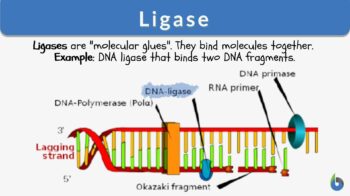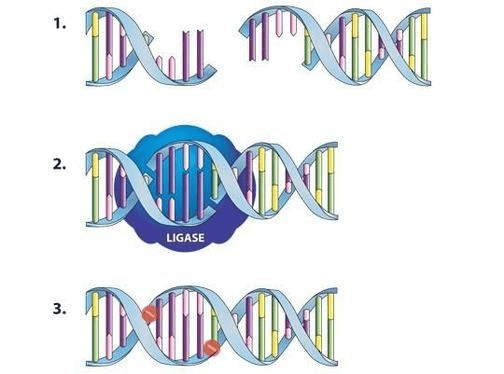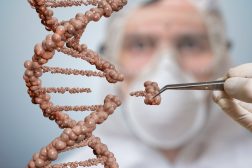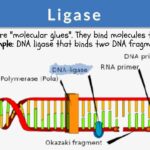
Ligase
n., plural: ligases
[ˈlaɪɡeɪz]
Definition: enzyme that catalyzes the binding of two molecules
Table of Contents
An enzyme is a catalyst or a chemical produced by cells to speed up a biochemical reaction. It is usually a protein molecule with a characteristic sequence of amino acids that fold to produce a three-dimensional structure, which gives the molecule its unique properties. Another molecule with catalytic activity is ribozyme, an enzyme made of RNA rather than protein. Enzymes may be classified and named according to the reaction they catalyze: (1) oxidoreductases, (2) transferases, (3) lyases, (4) isomerases, and (6) ligases. In essence, ligases are a group of enzymes that catalyze the binding of two molecules.
Ligase Definition
What is ligase? The word ‘ligase‘ came from the Latin word ‘ligare‘, which means “to bind”. In biology, ligase is a class of enzyme. But, what does ligase do? Let us define ligase.
Ligase is the class of enzyme that brings about the binding or joining of two molecules. It is, by definition in biology, the class of enzyme that catalyzes the binding or joining of two macromolecules by forming new bonds like C-O, C-N, and C-S. Ligase enzyme catalyzes the ligase reaction for, e.g.
A-D + X A-X + d
OR
B-C + V-W B-V + c + w + f + g
Wherein d, c, w, f, g represent small pendant groups that have been hydrolyzed during the process of ligation or joining of two macromolecules (e.g. A-X and B-V, in the above reactions).
About 50 ligase enzymes are known and are often referred to as “molecular glue”. DNA ligase is an example. It catalyzes the DNA fragments’ binding by forming a phosphodiester bond between complementary ends of the DNA fragments. Thus, DNA ligase plays a critical role in repairing, replicating, and recombination of DNA. Let us understand the ligase mechanism with the help of DNA Ligase as an example.
Ligase is an enzyme that catalyzes the binding of two molecules. An example is a DNA ligase that links two fragments of DNA by forming a phosphodiester bond. Ligases are classified into six subclasses: (1) EC 6.1 (ligases forming carbon-oxygen bonds), (2) EC 6.2 (ligases forming carbon-sulfur bonds), (3) EC 6.3 (ligases forming carbon-nitrogen bonds), (4) EC 6.4 (ligases forming carbon-carbon bonds), (5) EC 6.5 (ligases forming phosphoric ester bonds), and (6) EC 6.6 (ligases forming nitrogen-metal bonds). Synonym: synthetase.
DNA Ligase
Definition: DNA ligases are the ligases that join or bind the two DNA fragments (also known as Okazaki fragments) by forming a phosphodiester bond.
Functions of DNA Ligase
DNA Ligase is needed for DNA replication as well as the DNA repairing process. DNA Ligase is widely utilized in laboratories for carrying out recombinant DNA experiments. The most widely utilized ligase in a science laboratory is the DNA ligase.
READ: Ligase in Genetic Engineering
Mechanism of DNA Ligase
DNA ligase binds the 3′ hydroxyl ends of one nucleotide (or acceptor) with the 5′ phosphate end of another (donor) by two covalent phosphodiester bonds in the following steps:
- In the first step, the DNA fragments or DNA segments or Okazaki fragments are reorganized with their active sites.
- The lysine residue of the active site of the Ligase gets adenylated with the addition of AMP. The release of pyrophosphate accompanies adenylation of Ligase.
- Ligase transfer the AMP to the 5′ phosphate end of the donor with the formation of the pyrophosphate bond.
- The 5′ phosphate end of the donor is linked to the 3′ hydroxyl end of the receptor with phosphodiester bond formation.

Generally, these ligases are named according to the substrate or the macromolecules involved in the reaction; for, e.g., amino acid–RNA ligase catalyzes, the C-O bond formation between amino acid and transfer RNA.
Ligase enzymes are synonymous with synthetase enzymes. However, synthetase enzymes are often confused with synthase enzymes. Historically, synthetase enzymes were defined as the “ligase that catalyzes the joining of two macromolecules with the utilization of the energy molecules obtained by the hydrolysis of nucleoside triphosphates (like ATP, GTP, CTP, TTP, and UTP), for example, hydrolysis of adenosine triphosphate (ATP) molecules to adenosine diphosphate (ADP)”.
On the other hand, synthase enzymes are the ones that catalyze the synthesis of biological macromolecules without the hydrolysis of nucleoside triphosphates.
However, later Joint Commission on Biochemical Nomenclature (JCBN) announced that the term synthetase would be used synonymously with ligase. At the same time, ‘synthase’ would be used for the synthesis-catalyzing enzymes that may or may not involve energy utilization.
There are six classes of enzymes and ligases are one of them. The other classes of enzymes include oxidoreductases, transferases, hydrolases, isomerases, and lyases. Ligase and lyase are closely related classes of enzymes. However, Ligase and lyase are different classes of enzymes.
| Table 1: Lyase Vs Ligase | |
|---|---|
| Ligase | Lyase |
| Enzymes that bring about joining or binding of two biological macromolecules | Enzymes that catalyze the chemical bond breaking in a biological molecule |
| Bond formation | Bond cleavage |
| Ligase enzyme act via a hydrolysis reaction | Lyases act by reactions other than hydrolysis and oxidation. Lyases generally act by an elimination reaction |
| Ligase act on two molecules simultaneously | Lyase act on only one molecule at a time |
| DNA replication is completed with the help of DNA Ligase | Lyases are an important part of the glycolysis and Kreb cycle |
Ligase Function
- This class of enzymes plays a critical role by joining two complementary macromolecules like nucleic acid. DNA ligase enzymes carry out the repairing, replication, and recombination of DNA.
- Ligases are one of the most widely used enzymes in the molecular biology laboratory. Ligases are used in recombinant DNA cloning to bind annealed fragments of restriction endonuclease.
Classification
Based on the molecular bond catalyzed by the ligase enzyme, ligase can be classified into six subclasses (see Table 2).
| Table 2: six subclasses of ligases | ||
|---|---|---|
| Molecular bond involved | Ligase subclass | Example |
| Carbon-Oxygen bonds (C-O) | EC 6.1 | Aminoacyl tRNA synthetase |
| Carbon-Sulfur bonds (C-S) | EC 6.2 | Succinyl coenzyme A synthetase, Thiokinase |
| Carbon-Nitrogen bonds (C-N) | EC 6.3 | Ubiquitin ligase, argininosuccinate synthetase |
| Carbon-Carbon bonds (C-C) | EC 6.4 | Gamma-glutamyl carboxylase, Polyketide synthase |
| Phosphoric ester bonds | EC 6.5 | DNA ligase |
| Nitrogen-metal bonds | EC 6.6 | Chelatases |
Note: EC stands for Enzyme Commission
Ligase Examples
- Ubiquitin Ligases (C-N bond)
- Glutamate–cysteine ligase (C-N bond)
- Aminoacyl tRNA synthetase (C-O bond)
- Succinyl coenzyme A synthetase (C-S bond)
- Acetyl—CoA synthetase (C-S bond)
- Pyruvate carboxylase (C-C bond)
- Acetyl-CoA carboxylase (C-C bond)
- Propionyl-CoA carboxylase (C-C bond)
- Methylcrotonyl-CoA carboxylase (C-C bond)
- DNA ligase (Phosphoric ester bonds)
- Magnesium chelatase (Nitrogen-metal bonds)
- Cobalt chelatase (Nitrogen-metal bonds)
- DNA synthetase
Try to answer the quiz below to check what you have learned so far about ligases.
References
- Shuman S. (2009). DNA ligases: progress and prospects. The Journal of biological chemistry, 284(26), 17365–17369. https://doi.org/10.1074/jbc.R900017200.
- Doherty, A. J., & Suh, S. W. (2000). Structural and mechanistic conservation in DNA ligases. Nucleic acids research, 28(21), 4051–4058. https://doi.org/10.1093/nar/28.21.4051
- Holliday, G. L., Rahman, S. A., Furnham, N., & Thornton, J. M. (2014). Exploring the biological and chemical complexity of the ligases. Journal of molecular biology, 426(10), 2098–2111. https://doi.org/10.1016/j.jmb.2014.03.008
©BiologyOnline.com. Content provided and moderated by Biology Online Editors.



